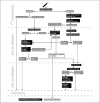Laboratory Monitoring of Mother, Fetus, and Newborn in Hemolytic Disease of Fetus and Newborn
- PMID: 34803574
- PMCID: PMC8578801
- DOI: 10.1159/000518782
Laboratory Monitoring of Mother, Fetus, and Newborn in Hemolytic Disease of Fetus and Newborn
Abstract
Background: Laboratory monitoring of mother, fetus, and newborn in hemolytic disease of fetus and newborn (HDFN) aims to guide clinicians and the immunized women to focus on the most serious problems of alloimmunization and thus minimize the consequences of HDFN in general and of anti-D in particular. Here, we present the current approach of laboratory screening and testing for prevention and monitoring of HDFN at the Copenhagen University Hospital in Denmark.
Summary: All pregnant women are typed and screened in the 1st trimester. This serves to identify the RhD-negative pregnant women who at gestational age (GA) of 25 weeks are offered a second screen test and a non-invasive fetal RhD prediction. At GA 29 weeks, and again after delivery, non-immunized RhD-negative women carrying an RhD-positive fetus are offered Rh immunoglobulin. If the 1st trimester screen reveals an alloantibody, antenatal investigation is initiated. This also includes RhD-positive women with alloantibodies. Specificity and titer are determined, the fetal phenotype is predicted by non-invasive genotyping based on cell-free DNA (RhD, K, Rhc, RhC, RhE, ABO), and serial monitoring of titer commences. Based on titers and specificity, monitoring with serial peak systolic velocity measurements in the fetal middle cerebral artery to detect anemia will take place. Intrauterine transfusion is given when fetal anemia is suspected. Monitoring of the newborn by titer and survival of fetal red blood cells by flow cytometry will help predict the length of the recovery of the newborn.
Keywords: Alloimmunization; Cell-free DNA; Hemolytic disease of fetus and newborn; Middle cerebral artery, Peak systolic velocity; Next-generation sequencing.
Copyright © 2021 by S. Karger AG, Basel.
Conflict of interest statement
The authors declare no conflicts of interest.
Figures


Similar articles
-
Determination of fetal RHD type in plasma of RhD negative pregnant women.Scand J Clin Lab Invest. 2018 Sep;78(5):411-416. doi: 10.1080/00365513.2018.1475681. Epub 2018 Jun 5. Scand J Clin Lab Invest. 2018. PMID: 29869532
-
Routine administration of Anti-D: the ethical case for offering pregnant women fetal RHD genotyping and a review of policy and practice.BMC Pregnancy Childbirth. 2014 Feb 25;14:87. doi: 10.1186/1471-2393-14-87. BMC Pregnancy Childbirth. 2014. PMID: 24568571 Free PMC article. Review.
-
Prevalence and specificity of clinically significant red cell alloantibodies in pregnant women - a study from a tertiary care hospital in Southeast Michigan.J Blood Med. 2019 Aug 20;10:283-289. doi: 10.2147/JBM.S214118. eCollection 2019. J Blood Med. 2019. PMID: 31692490 Free PMC article.
-
Hemolytic disease of the fetus and newborn in the molecular era.Semin Fetal Neonatal Med. 2016 Feb;21(1):28-34. doi: 10.1016/j.siny.2015.10.006. Epub 2015 Nov 14. Semin Fetal Neonatal Med. 2016. PMID: 26589360 Review.
-
Hemolytic disease of the fetus and newborn caused by anti-D and anti-S alloantibodies: a case report.J Med Case Rep. 2012 Feb 20;6:71. doi: 10.1186/1752-1947-6-71. J Med Case Rep. 2012. PMID: 22348809 Free PMC article.
Cited by
-
Colombian consensus for the diagnosis, prevention, and management of Rhesus disease.Rev Colomb Obstet Ginecol. 2024 Sep 30;75(3):4142. doi: 10.18597/rcog.4142. Rev Colomb Obstet Ginecol. 2024. PMID: 39530874 Free PMC article. English, Spanish.
-
Neonatal Hemolytic Jaundice: Causes, Diagnostic Approach, and Management.Children (Basel). 2025 May 23;12(6):666. doi: 10.3390/children12060666. Children (Basel). 2025. PMID: 40564624 Free PMC article. Review.
-
Noninvasive fetal blood group antigen genotyping.Blood Transfus. 2025 Mar;23(2):101-108. doi: 10.2450/BloodTransfus.712. Epub 2024 Jan 29. Blood Transfus. 2025. PMID: 38315532 Free PMC article. Review.
-
Neonatal Jka hemolytic disease combined with alloimmune thrombocytopenia with extreme anemia: a case report with literature review.BMC Pediatr. 2025 May 19;25(1):398. doi: 10.1186/s12887-025-05749-8. BMC Pediatr. 2025. PMID: 40383791 Free PMC article. Review.
-
Hemolytic disease of the fetus and newborn: systematic literature review of the antenatal landscape.BMC Pregnancy Childbirth. 2023 Jan 7;23(1):12. doi: 10.1186/s12884-022-05329-z. BMC Pregnancy Childbirth. 2023. PMID: 36611144 Free PMC article.
References
-
- Bowman JM, Pollock JM, Penston LE. Fetomaternal transplacental hemorrhage during pregnancy and after delivery. Vox Sang. 1986;51((2)):117–21. - PubMed
-
- de Haas M, Thurik FF, Koelewijn JM, van der Schoot CE. Haemolytic disease of the fetus and newborn. Vox Sang. 2015 Aug;109((2)):99–113. - PubMed
-
- Koelewijn JM, Vrijkotte TG, de Haas M, van der Schoot CE, Bonsel GJ. Risk factors for the presence of non-rhesus D red blood cell antibodies in pregnancy. BJOG. 2009 Apr;116((5)):655–64. - PubMed
-
- Firan M, Bawdon R, Radu C, Ober RJ, Eaken D, Antohe F, et al. The MHC class I-related receptor, FcRn, plays an essential role in the maternofetal transfer of gamma-globulin in humans. Int Immunol. 2001 Aug;13((8)):993–1002. - PubMed
-
- Simister NE, Mostov KE. An Fc receptor structurally related to MHC class I antigens. Nature. 1989 Jan 12;337((6203)):184–7. - PubMed
Publication types
LinkOut - more resources
Full Text Sources

